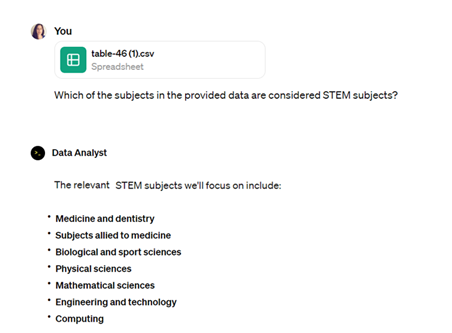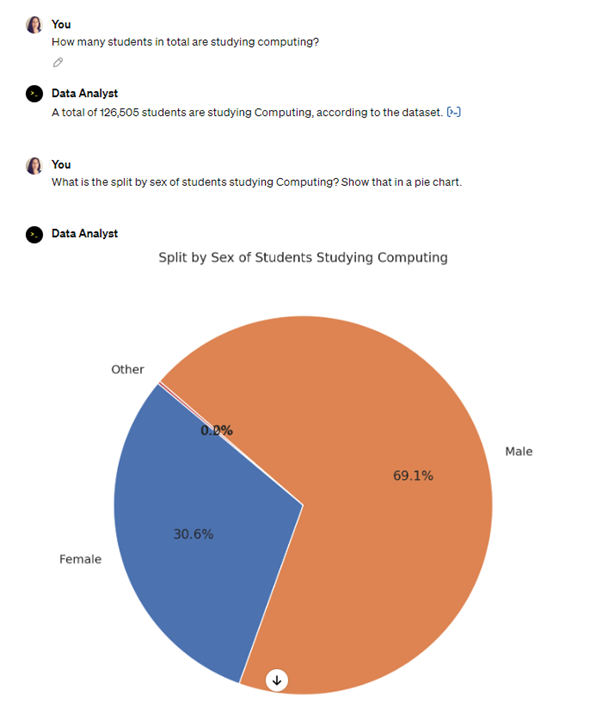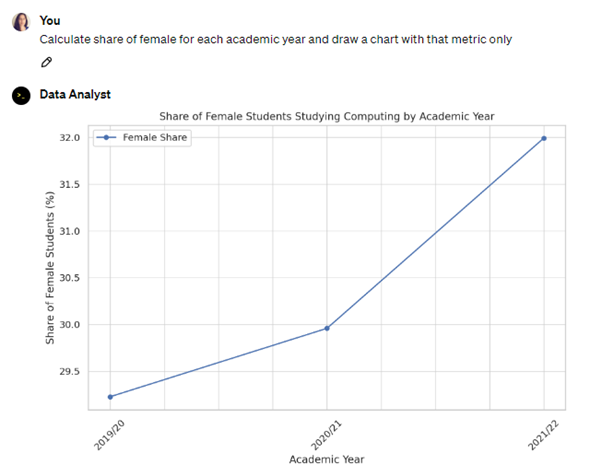In honour of International Women’s Day, we delve into the realm of self-serve analytics to illuminate the journey and progress of women in STEM (Science, Technology, Engineering, and Mathematics) fields. Using ChatGPT Data Analyst, we uncover insights from academic enrolment data, highlighting the evolving landscape of gender diversity within these critical sectors.
The Advent of Self-Serve Analytics
In the digital age, data is everywhere around us. Yet, the true potential of this data can only be unlocked through effective analysis and interpretation. Enter ChatGPT Data Analyst – an advanced tool designed to make data analytics accessible to researchers, educators, and decision-makers irrespective of their technical expertise. This AI-powered assistant epitomises the shift towards self-serve analytics, enabling users to ask complex questions and receive insights in real-time. This blog demonstrates using the intuitive conversational interface before mentioning some of its limitations.
Unveiling the State of Women in STEM
With a keen interest in gender diversity within STEM, we sought to answer the question: “Are more women studying STEM subjects?” To address this, we inputted a dataset detailing student enrolments in various subjects at the postgraduate level in the UK, spanning academic years from 2019/20 to 2021/22.
Utilising ChatGPT Data Analyst, we navigated through the dataset, identifying subjects classified under STEM and analysing the enrolment numbers by sex. Our investigation revealed distinct STEM fields, including Medicine and Dentistry, Biological Sciences, Engineering and Technology, and Computing, among others.

Key Findings: A Glimpse into Gender Diversity
As a tech agency, we want to understand enrolment trends in the Computing field. We discovered that, as of 2021/22, a total of 126,505 students were studying Computing, with the analysis revealing a detailed breakdown by sex. To further explore the gender dynamics, we compared the split by sex across three academic years, identifying a persistent gender gap but also signs of gradual improvement.



The ChatGPT Data Analyst proved its effectiveness as we calculated the share of female students for each academic year; it presented a clear, visual picture of how many women were participating in Computing. This analysis not only provided quantitative evidence of the challenges faced in achieving gender equality but also highlighted the progress being made, albeit slowly.
Celebrating Progress and Acknowledging Challenges
This International Women’s Day, our analysis serves as both a celebration of the strides women have made in STEM and a reminder of the journey ahead. The insights gleaned through ChatGPT Data Analyst underscore the importance of leveraging technology to foster an inclusive environment where women’s contributions to STEM are recognised and encouraged.
However, it’s crucial to acknowledge the limitations inherent in tools like ChatGPT Data Analyst. These tools are only as effective as the data they’re given, highlighting the necessity of ensuring diverse and representative datasets to draw accurate and meaningful conclusions.
As we continue to navigate the path towards gender equality in STEM, tools like ChatGPT Data Analyst can play a crucial role in highlighting areas of progress and pinpointing where concerted efforts are needed. Let’s commit to using every tool at our disposal, including the power of data analytics, to champion the cause of women in STEM, not just on International Women’s Day, but every day. Together, we can build a more equitable and diverse future for the next generation of scientists, engineers, and technology professionals.